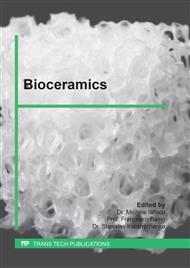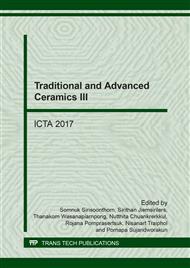p.258
p.264
p.270
p.276
p.282
p.288
p.294
p.300
p.305
Enhancing the Phase Conversion of Hydroxyapatite from Calcium Sulphate Hemihydrate by Hydrothermal Reaction
Abstract:
Hydroxyapatite (HA) is a well-known biocompatible material which is widely used in orthopedic and dental applications. Because its chemical structure is similar to the human bone so it is compatible to use as a based materials in drug delivery system for treatment of bone infection diseases. In this research we focused on fabrication of HA sphere shape by three dimension printing using calcium sulphate hemihydrate (CaSO4·0.5H2O) as a starting material, then the as-three dimension printed CaSO4·0.5H2O spheres were hydrothermally treated in 1M disodium hydrogenphosphate (Na2HPO4) at 100°C-180°C for 2-8 hr. The reaction was taken place and the conversion of CaSO4·0.5H2O was gradually changed to Ca10(PO4)6(OH)2. Phase analysis by X-ray diffraction indicated that monetite (CaHPO4) was coexisted with HA when hydrothermally treated at pH 9 at low reaction temperature (<180°C). When the pH of 1M Na2HPO4 was adjusted to pH 11, 180°C for 6 hr, the as-three dimension printed calcium sulphate hemihydrate spheres were completely converted to HA spheres without any destruction of the sphere shape. This is confirmed that hydrothermal reaction could enhance the phase conversion of HA and the conversion time was four times faster than the normal conversion.
Info:
Periodical:
Pages:
288-293
Citation:
Online since:
April 2018
Price:
Сopyright:
© 2018 Trans Tech Publications Ltd. All Rights Reserved
Share:
Citation:



